New Testament Apocrypha
Lesson 1
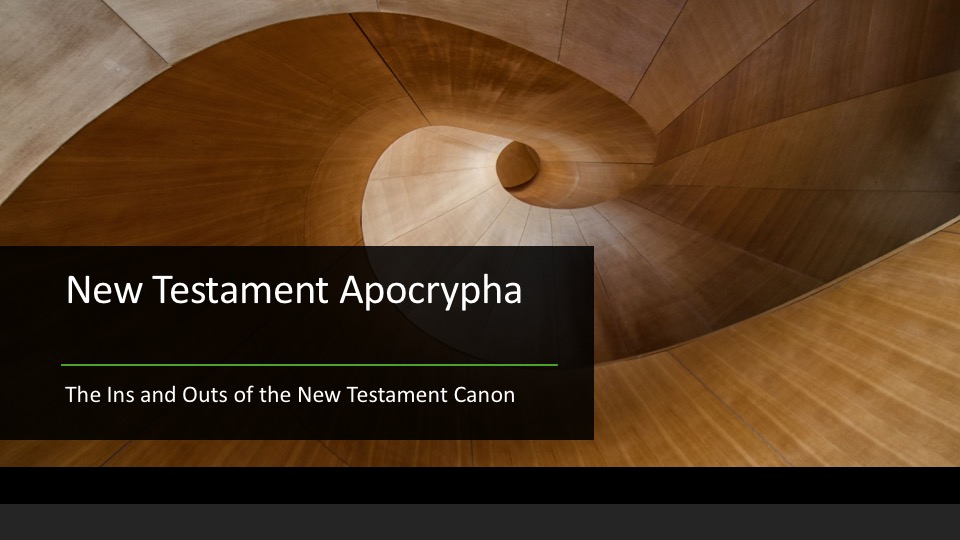
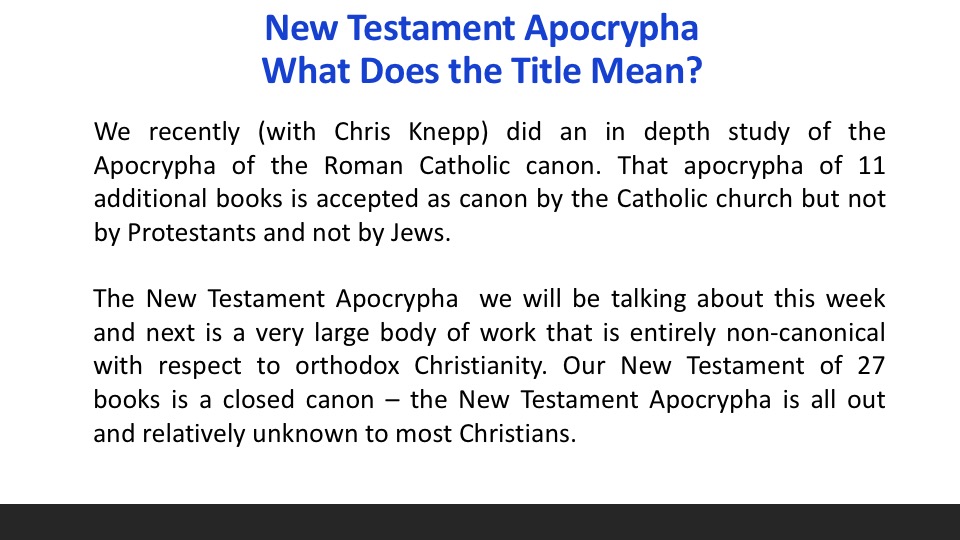
New
Testament Apocrypha
What Does the Title Mean?
We recently (with Chris Knepp) did an in depth study of the Apocrypha of the Roman Catholic canon. That apocrypha of 11 additional books is accepted as canon by the Catholic church but not by Protestants and not by Jews.
The New Testament Apocrypha we will be talking about this week and next is a very large body of work that is entirely non-canonical with respect to orthodox Christianity. Our New Testament of 27 books is a closed canon – the New Testament Apocrypha is all out and relatively unknown to most Christians.
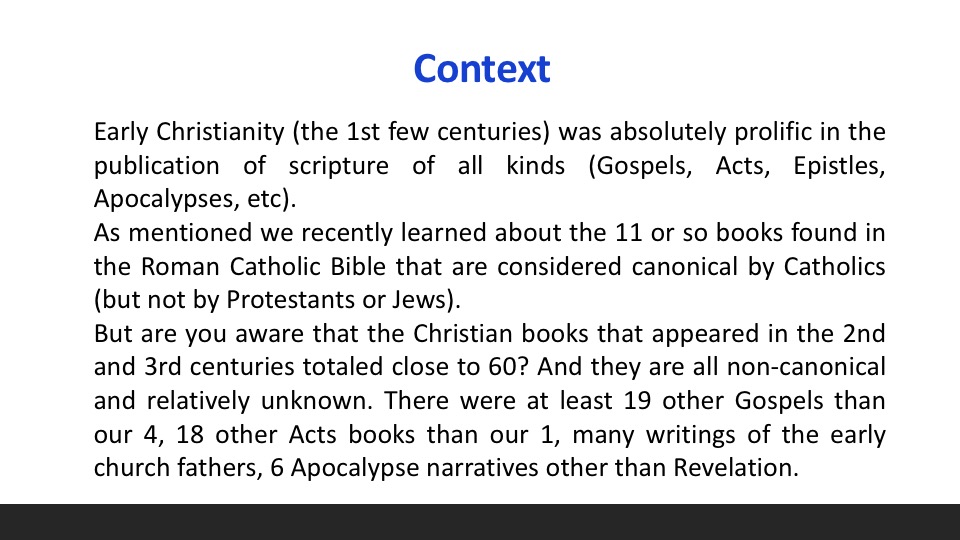
Context
Early Christianity (the 1st few centuries) was absolutely prolific in the publication of scripture of all kinds (Gospels, Acts, Epistles, Apocalypses, etc).
As mentioned we recently learned about the 11 or so books found in the Roman Catholic Bible that are considered canonical by Catholics (but not by Protestants or Jews).
But are you aware that the Christian books that appeared in the 2nd and 3rd centuries totaled close to 60? And they are all non-canonical and relatively unknown. There were at least 19 other Gospels than our 4, 18 other Acts books than our 1, many writings of the early church fathers, 6 Apocalypse narratives other than Revelation.
We will explore why these did not make the canon. And talk about a few that almost did.
And we will find that there are some that we have almost no copies of (either non-existent or only in fragments), but on the other hand, some of which were very popular and widely read and still available to be read today. And some ideas from these books that may have crept into orthodox Christian thinking.
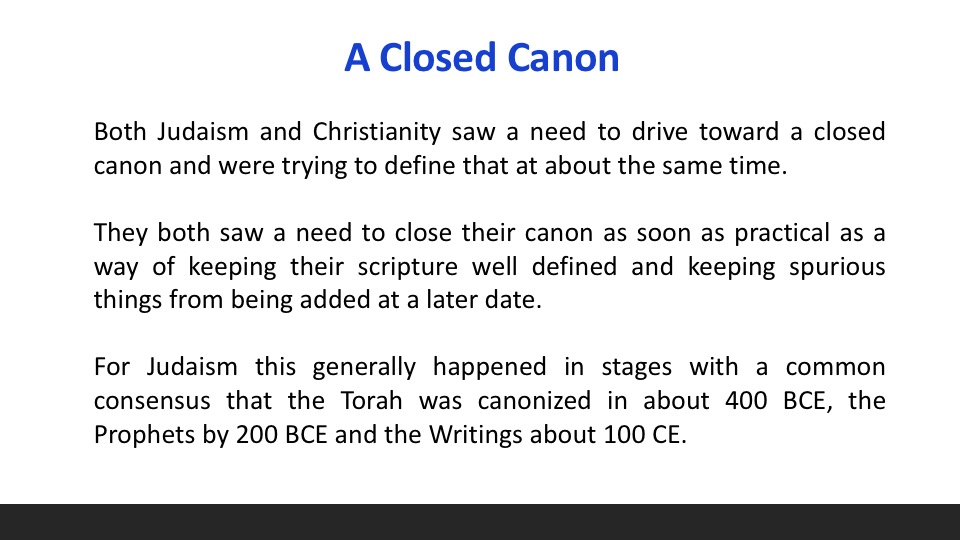
A Closed Canon
Both Judaism and Christianity saw a need to drive toward a closed canon and were trying to define that at about the same time.
They both saw a need to close their canon as soon as practical as a way of keeping their scripture well defined and keeping spurious things from being added at a later date.
For Judaism this generally happened in stages with a common consensus that the Torah was canonized in about 400 BCE, the Prophets by 200 BCE and the Writings about 100 CE.
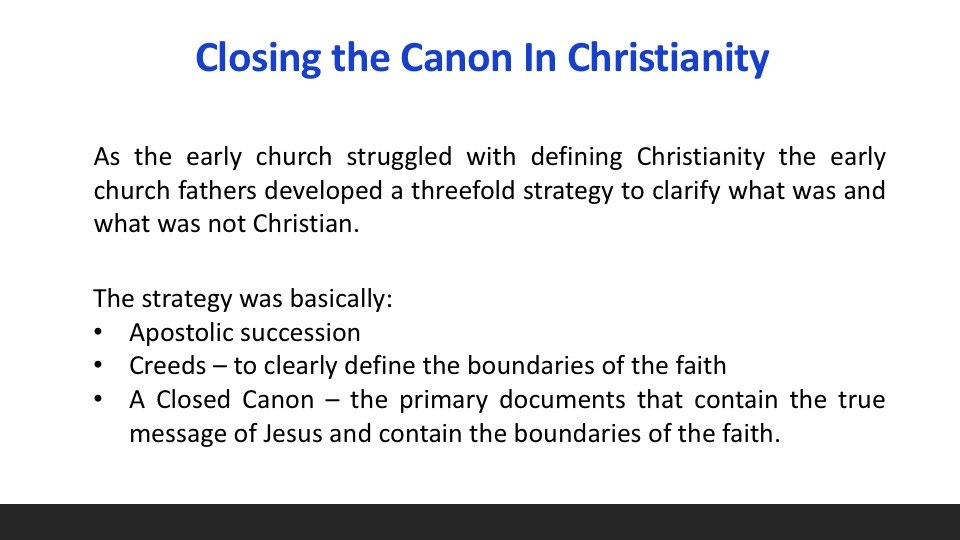
Closing the Canon In Christianity
As the early church struggled with defining Christianity the early church fathers developed a threefold strategy to clarify what was and what was not Christian.
The strategy was basically:
• Apostolic succession
• Creeds – to clearly define the boundaries of the faith
• A Closed Canon – the primary documents that contain the true message of Jesus and contain the boundaries of the faith.
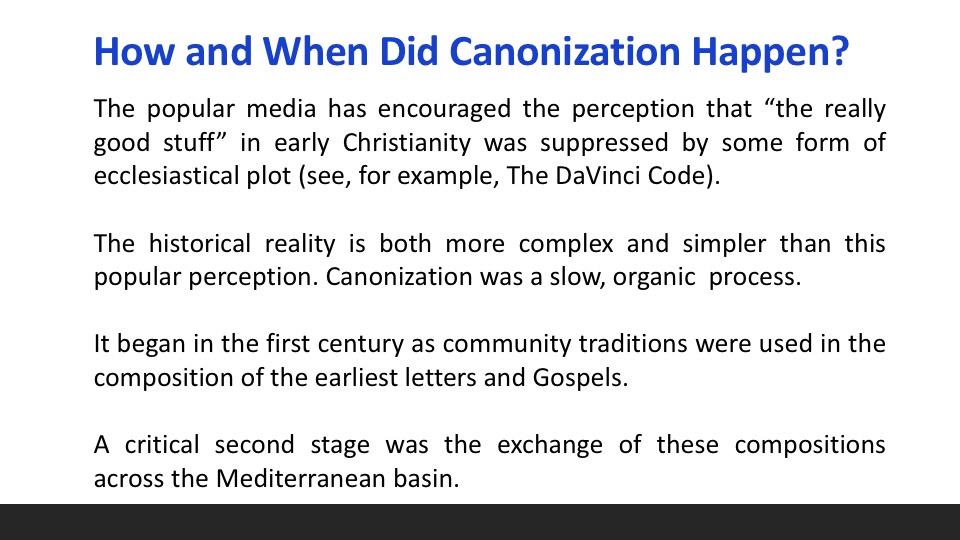
How and When Did Canonization Happen?
The popular media has encouraged the perception that “the really good stuff” in early Christianity was suppressed by some form of ecclesiastical plot (see, for example, The DaVinci Code).
The historical reality is both more complex and simpler than this popular perception. Canonization was a slow, organic process.
It began in the first century as community traditions were used in the composition of the earliest letters and Gospels.
A critical second stage was the exchange of these compositions across the Mediterranean basin.
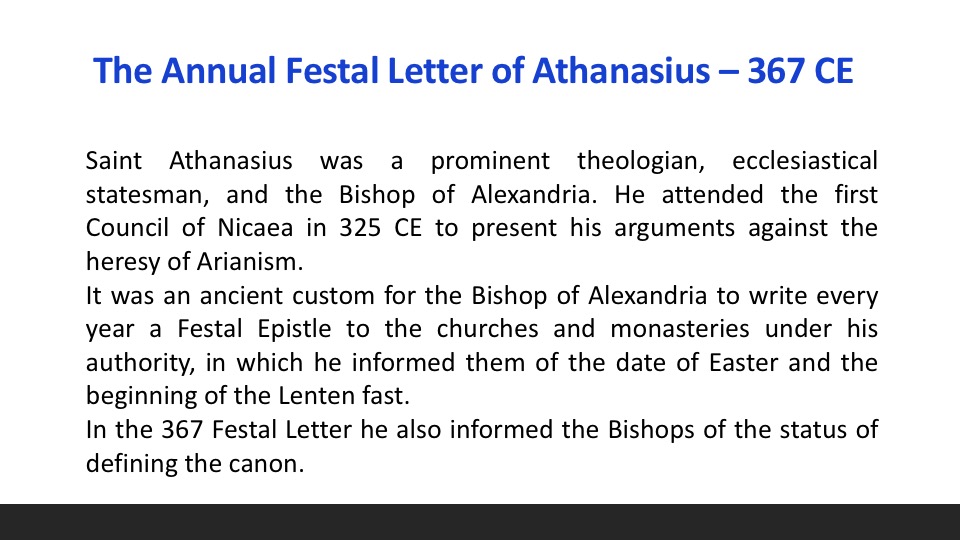
The Annual Festal Letter of Athanasius – 367 CE
Saint Athanasius was a prominent theologian, ecclesiastical statesman, and the Bishop of Alexandria. He attended the first Council of Nicaea in 325 CE to present his arguments against the heresy of Arianism.
It was an ancient custom for the Bishop of Alexandria to write every year a Festal Epistle to the churches and monasteries under his authority, in which he informed them of the date of Easter and the beginning of the Lenten fast.
In the 367 Festal Letter he also informed the Bishops of the status of defining the canon.
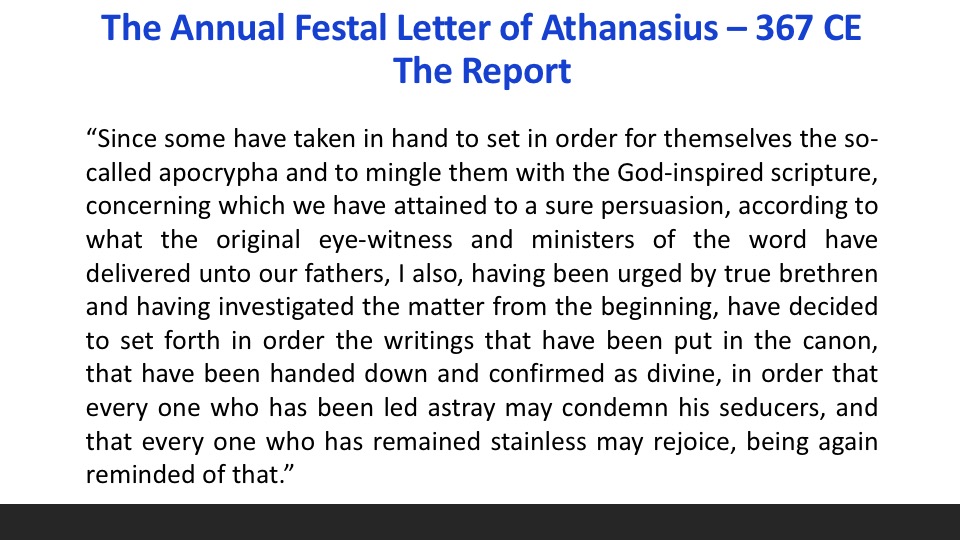
The Annual Festal Letter of Athanasius – 367 CE
Since some have taken in hand to set in order for themselves the so-called apocrypha and to mingle them with the God-inspired scripture, concerning which we have attained to a sure persuasion, according to what the original eye-witness and ministers of the word have delivered unto our fathers, I also, having been urged by true brethren and having investigated the matter from the beginning, have decided to set forth in order the writings that have been put in the canon, that have been handed down and confirmed as divine, in order that every one who has been led astray may condemn his seducers, and that every one who has remained stainless may rejoice, being again reminded of that.
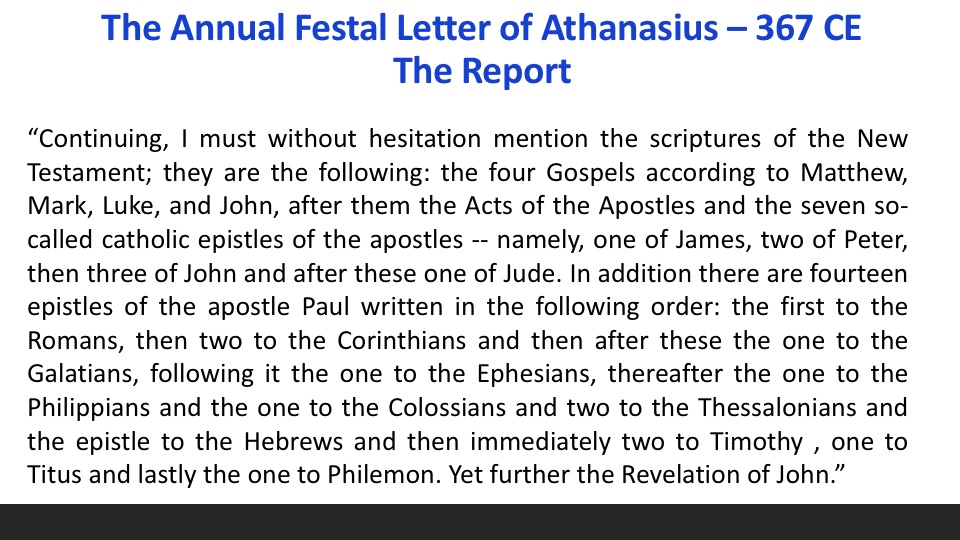
The Annual Festal Letter of Athanasius – 367 CE
Continuing, I must without hesitation mention the scriptures of the New Testament; they are the following: the four Gospels according to Matthew, Mark, Luke, and John, after them the Acts of the Apostles and the seven so-called catholic epistles of the apostles -- namely, one of James, two of Peter, then three of John and after these one of Jude. In addition there are fourteen epistles of the apostle Paul written in the following order: the first to the Romans, then two to the Corinthians and then after these the one to the Galatians, following it the one to the Ephesians, thereafter the one to the Philippians and the one to the Colossians and two to the Thessalonians and the epistle to the Hebrews and then immediately two to Timothy , one to Titus and lastly the one to Philemon. Yet further the Revelation of John.
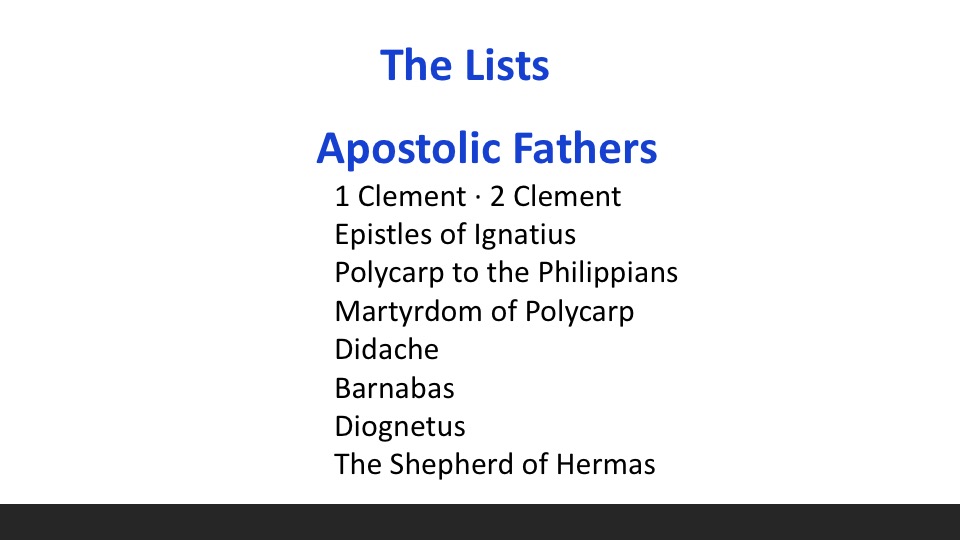
Apostolic Fathers
1 Clement · 2
Clement
Epistles of Ignatius
Polycarp to the Philippians
Martyrdom of Polycarp
Didache Barnabas Diognetus
The Shepherd of Hermas
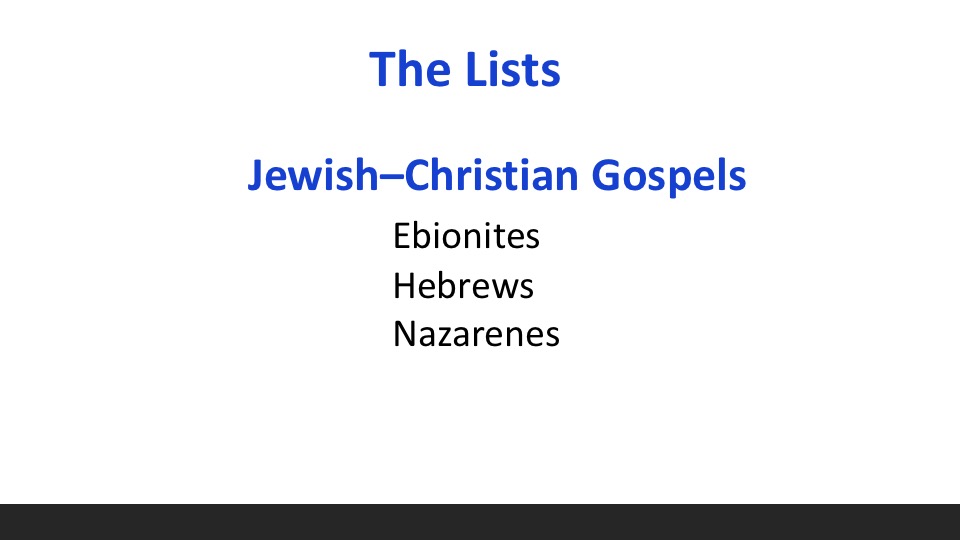
Jewish–Christian gospels
Ebionites
Hebrews
Nazarenes
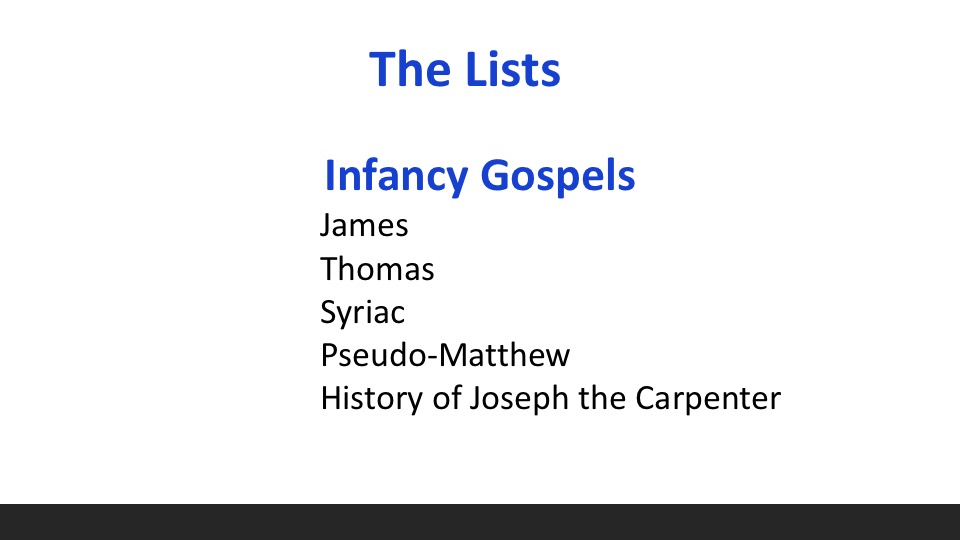
Infancy Gospels
James
Thomas
Syriac
Pseudo-Matthew
History of Joseph the Carpenter
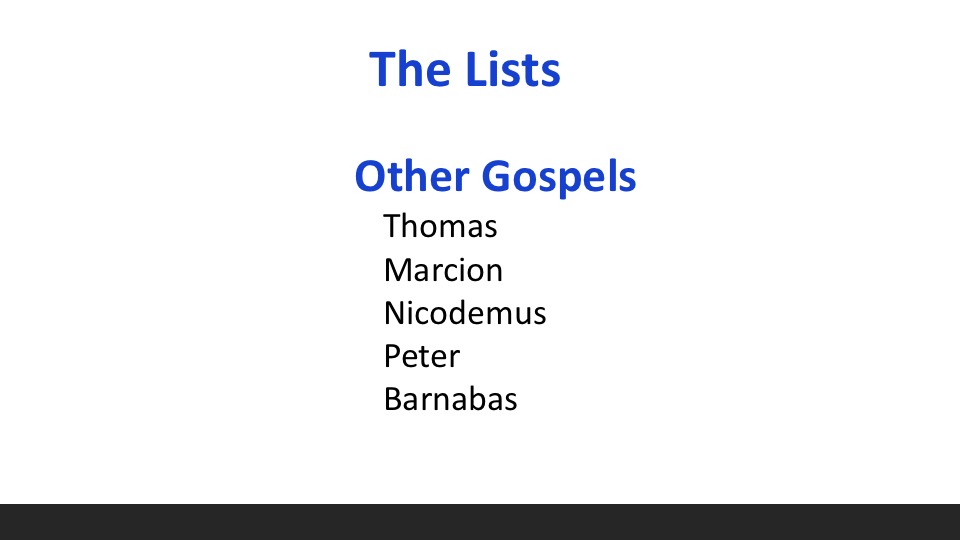
Other Gospels
Thomas
Marcion
Nicodemus
Peter
Barnabas
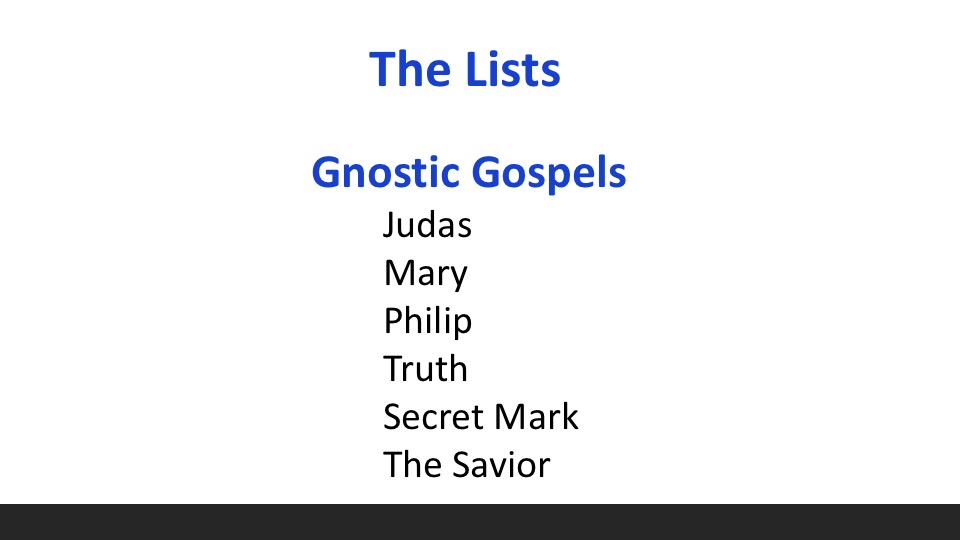
Gnostic Gospels
Judas
Mary
Philip
Truth
Secret Mark
The Saviour
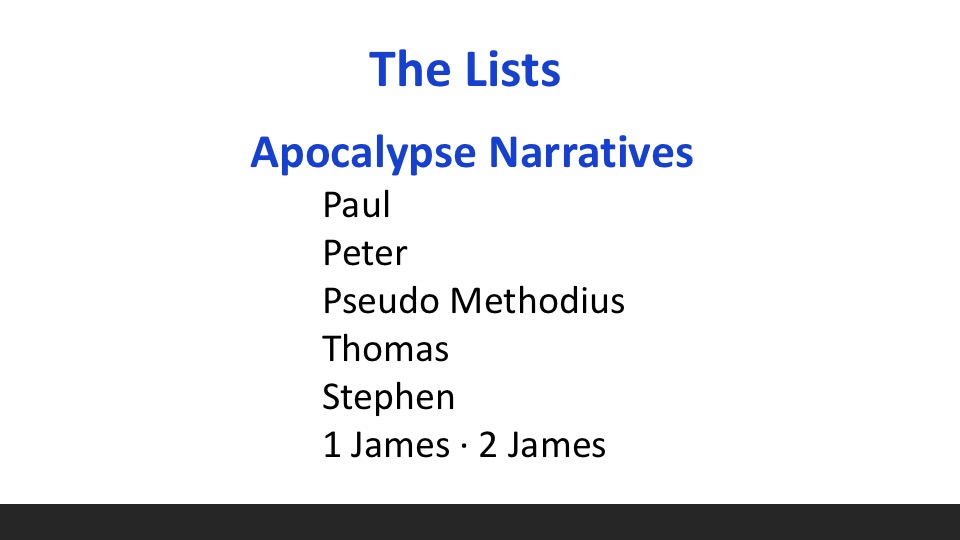
Apocalypse Narratives
Paul
Peter
Pseudo-Methodius
Thomas
Stephen
1 James
2 James
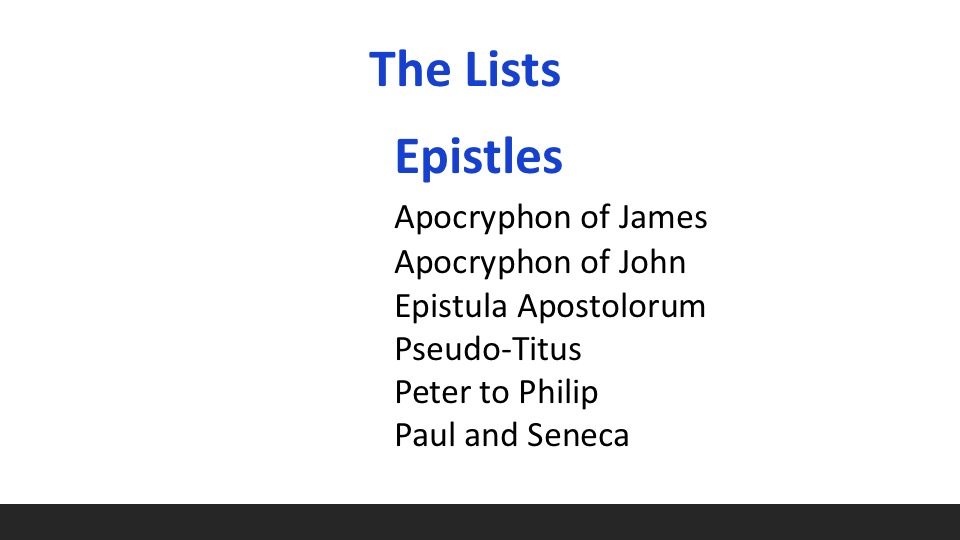
Epistles
Apocryphon of James
Apocryphon of
John
Epistula Apostolorum
Pseudo-Titus
Peter to Philip
Paul and Seneca
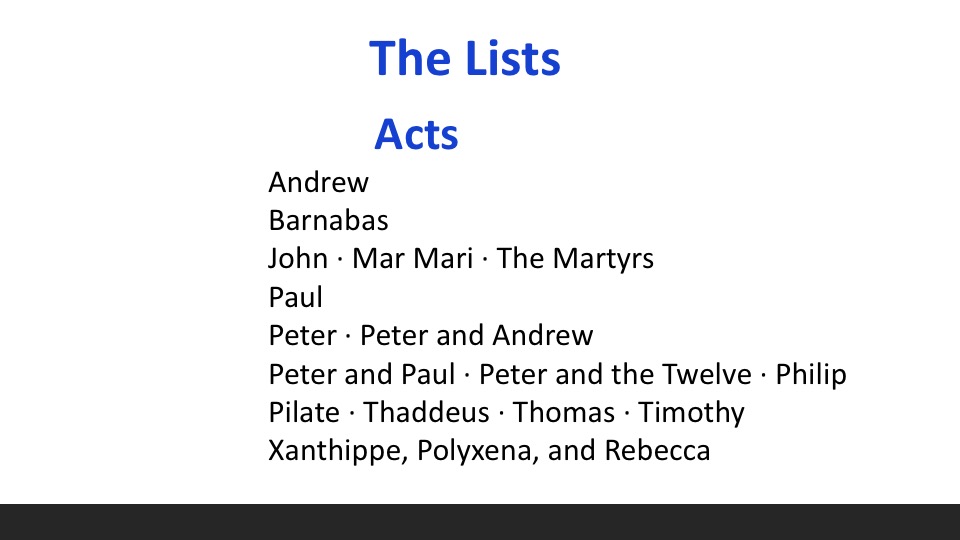
Acts
Andrew · Barnabas · John · Mar
Mari · The Martyrs
Paul
Peter · Peter and Andrew
Peter and Paul · Peter and the
Twelve · Philip
Pilate · Thaddeus · Thomas · Timothy
Xanthippe, Polyxena, and Rebecca
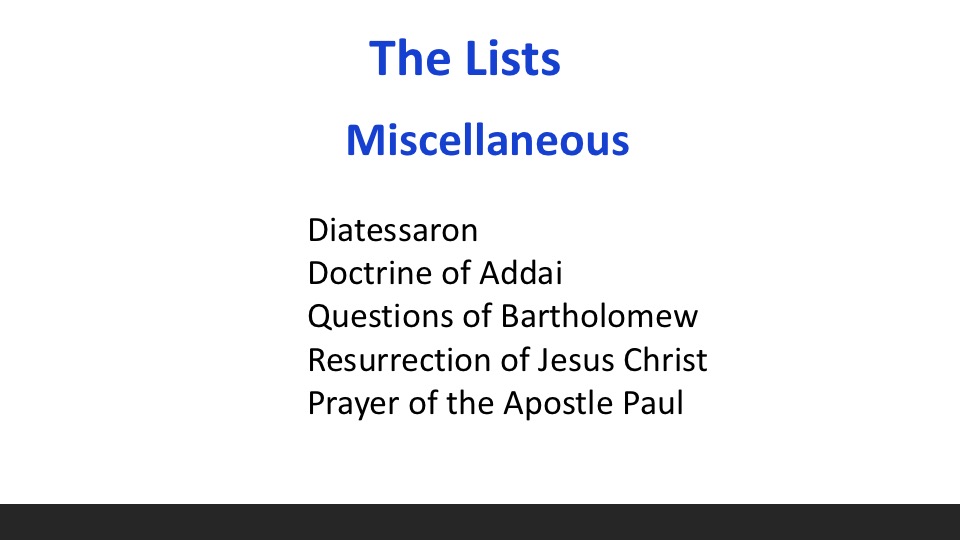
Miscellaneous
Diatessaron
Doctrine of Addai
Questions of Bartholomew
Resurrection of Jesus Christ
Prayer of the Apostle Paul
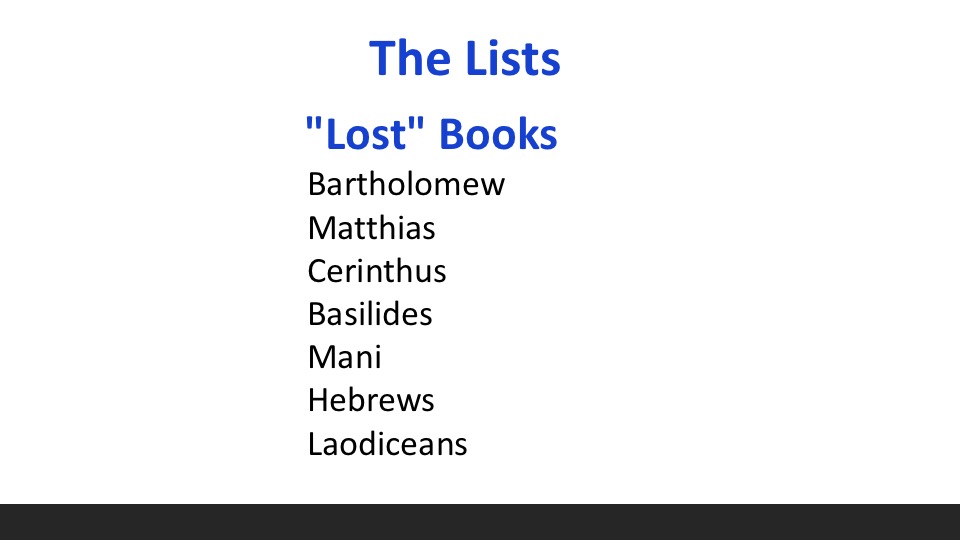
"Lost" Books
Bartholomew
Matthias
Cerinthus
Basilides
Mani
Hebrews
Laodiceans
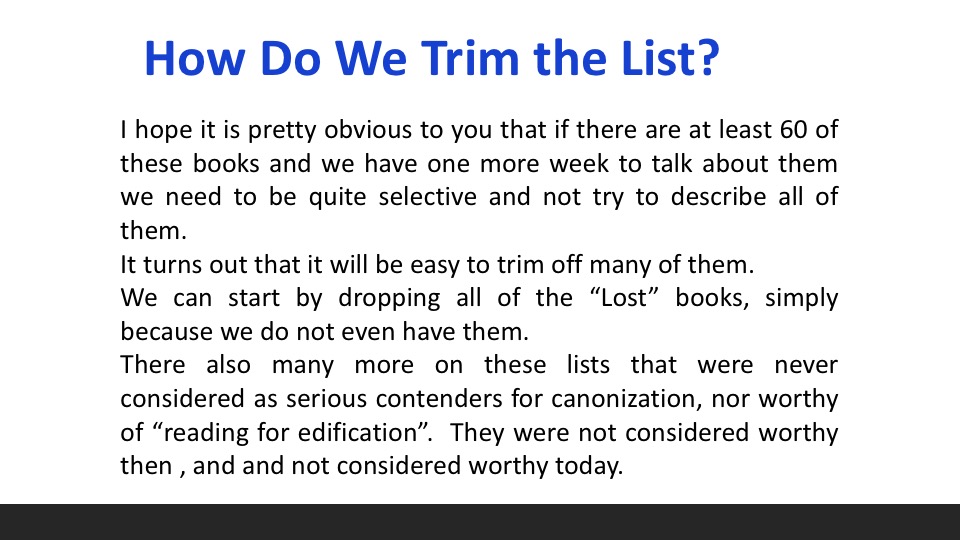
How Do We Trim the List?
I hope it is pretty obvious to you that if there are at least 60 of these books and we have one more week to talk about them we need to be quite selective and not try to describe all of them.
It turns out that it will be easy to trim off many of them.
We can start by dropping all of the “Lost” books, simply because we do not even have them.
And quite a few more exist only in fragments, with major parts missing.
There also many more on these lists that were never considered as serious contenders for canonization, nor worthy of “reading for edification”. They were not considered worthy then , and and not considered worthy today.
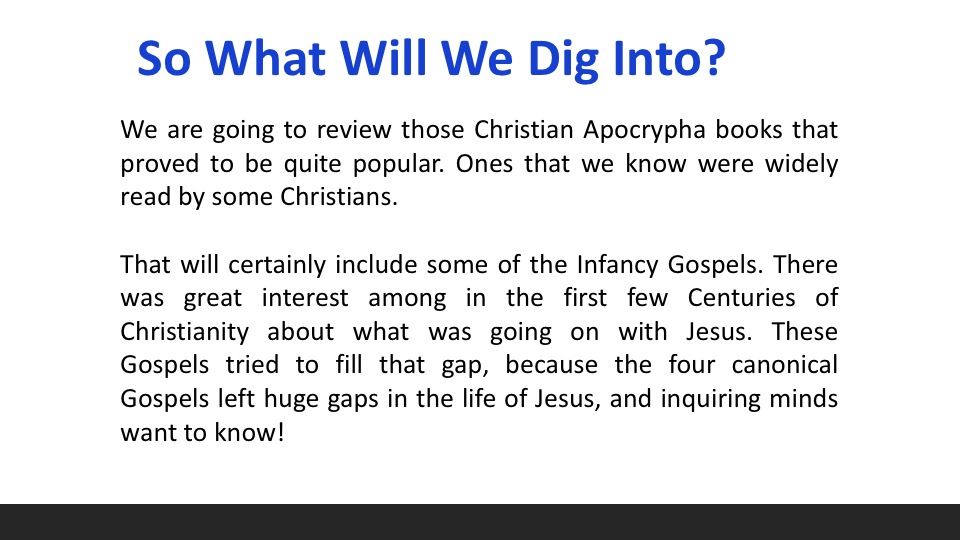
So What Will We Dig Into?
We are going to review those Christian Apocrypha books that proved to be quite popular. Ones that we know were widely read by some Christians.
That will certainly include some of the Infancy Gospels. There was great interest among in the first few Centuries of Christianity about what was going on with Jesus. These Gospels tried to fill that gap, because the four canonical Gospels left huge gaps in the life of Jesus, and inquiring minds want to know!
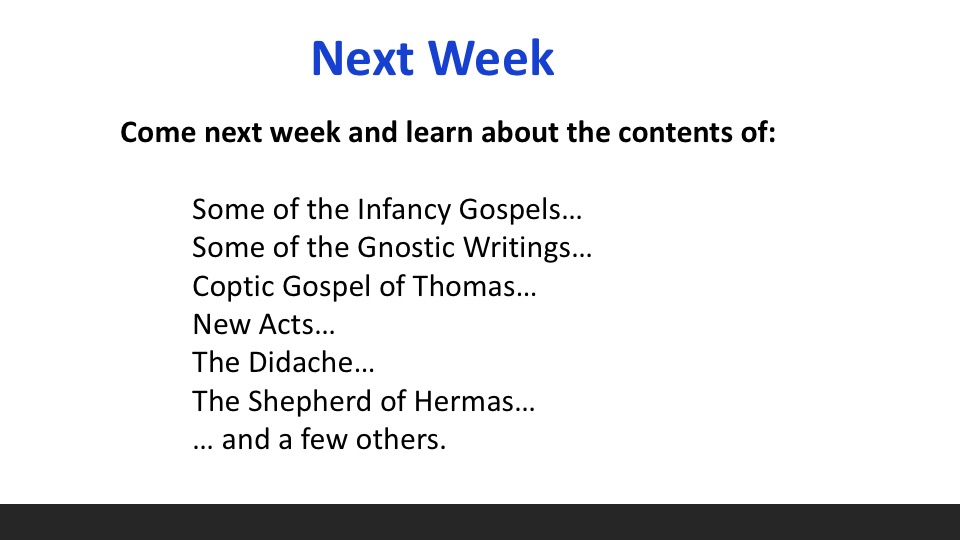
Next Week
Come next week and learn about the contents of:
- Some of the Infancy Gospels
- Some of the Gnostic Writings
- New Acts
- The Didache
- The Shepherd of Hermas
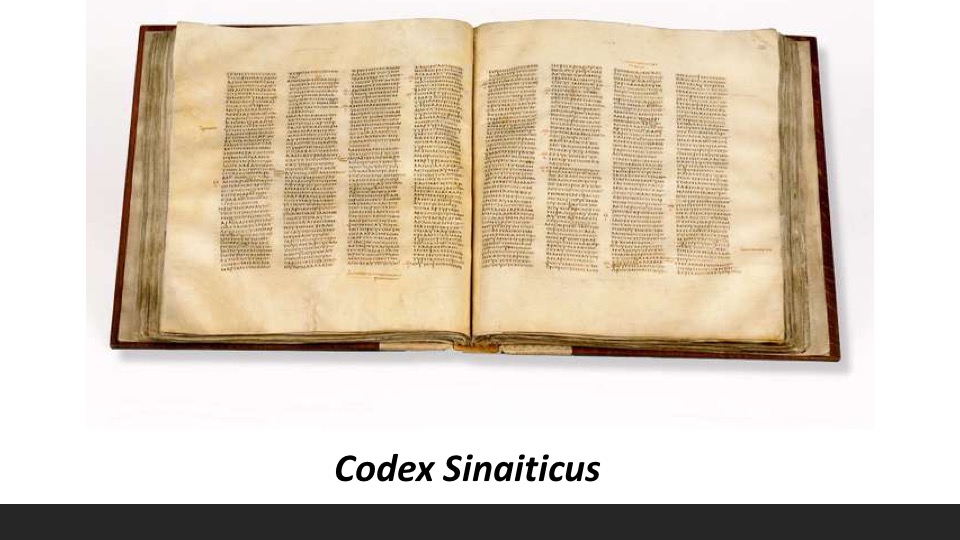
And by the way our friend Saint Athanasius in 367 who defined the 27 books of the New Testament that "made the cut", specifically called out the Didache and the Shepherd of Hermas as books worthy to be read by good Christians, even those they might not have been divinely inspired. And if you remember the story we covered last year in our review of the story of the Bible when Codex Sinaiticus was discovered in the monastery at Mount Sinai, that book, which was believed to be one of the 50 books to be produced on vellum for the new churches in Constantinople, actually had the Sheperd of Hermas in it, right after the book of Revelation.